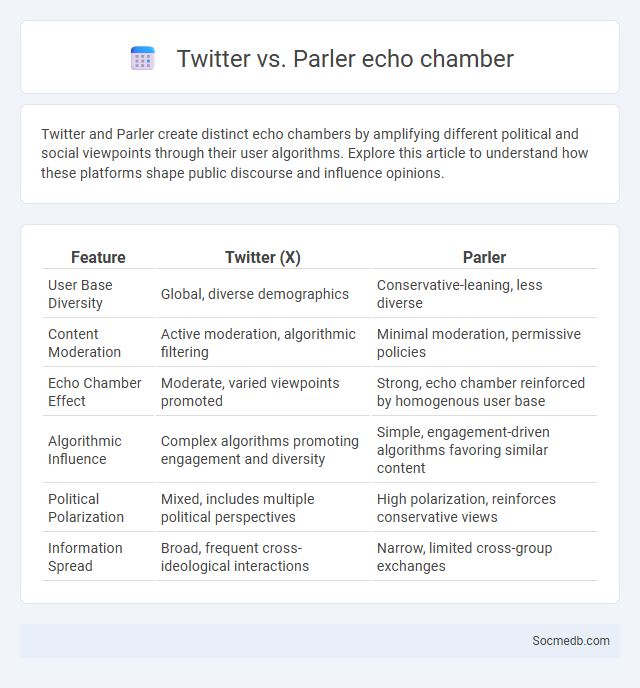
Photo illustration: Twitter vs Parler echo chamber
Twitter and Parler create distinct echo chambers by amplifying different political and social viewpoints through their user algorithms. Explore this article to understand how these platforms shape public discourse and influence opinions.
Table of Comparison
| Feature | Twitter (X) | Parler |
|---|---|---|
| User Base Diversity | Global, diverse demographics | Conservative-leaning, less diverse |
| Content Moderation | Active moderation, algorithmic filtering | Minimal moderation, permissive policies |
| Echo Chamber Effect | Moderate, varied viewpoints promoted | Strong, echo chamber reinforced by homogenous user base |
| Algorithmic Influence | Complex algorithms promoting engagement and diversity | Simple, engagement-driven algorithms favoring similar content |
| Political Polarization | Mixed, includes multiple political perspectives | High polarization, reinforces conservative views |
| Information Spread | Broad, frequent cross-ideological interactions | Narrow, limited cross-group exchanges |
Introduction: Understanding Echo Chambers
Echo chambers on social media occur when algorithms and user behaviors create environments where you are exposed primarily to information and opinions that reinforce your existing beliefs. This phenomenon limits diverse perspectives, intensifying polarization and reducing critical thinking. Recognizing echo chambers is essential for navigating social platforms with awareness and seeking balanced content.
Social Media and Echo Chambers: An Overview
Social media platforms amplify echo chambers by using algorithms that prioritize content aligned with users' existing beliefs, limiting exposure to diverse perspectives. These digital environments reinforce confirmation biases, intensifying polarization and reducing open dialogue among different groups. Studies indicate that echo chambers contribute significantly to misinformation spread and societal fragmentation in online communities.
Twitter’s Algorithms: Fostering Echo Chambers
Twitter's algorithms prioritize content that aligns with your previous interactions, reinforcing existing beliefs and limiting exposure to diverse perspectives. This targeted content delivery creates echo chambers, where users primarily engage with like-minded opinions, intensifying polarization. By curating feeds based on engagement metrics, Twitter's system shapes your information environment, influencing public discourse and social dynamics.
Parler’s Community: Reinforcing Homogeneous Beliefs
Parler's community exemplifies the reinforcement of homogeneous beliefs by fostering an echo chamber where users with similar political and social views share content and engage predominantly with like-minded individuals. This selective exposure limits diverse perspectives, amplifying confirmation bias and polarized discourse. The platform's algorithmic design and user base contribute to a reinforcing cycle that solidifies ideological conformity and reduces critical engagement across varying viewpoints.
Echo Chamber Dynamics: Twitter vs. Parler
Echo chamber dynamics on social media platforms like Twitter and Parler significantly influence the flow of information and user engagement. Twitter's diverse user base and algorithmic content curation create a complex network where varied perspectives coexist but often reinforce existing beliefs through retweets and likes. Parler, designed for minimal content moderation, amplifies homogeneous viewpoints, intensifying echo chamber effects and shaping your exposure to politically aligned communities more exclusively.
Content Moderation Policies and Their Impact
Content moderation policies on social media platforms are essential for curbing misinformation, hate speech, and harmful content while balancing free expression and user engagement. These policies rely on a combination of artificial intelligence algorithms and human moderators to identify and remove violations, directly affecting user experience and platform reputation. The effectiveness of content moderation influences public trust, regulatory scrutiny, and the overall health of online communities.
User Behavior Patterns on Twitter and Parler
User behavior patterns on Twitter reveal high engagement with trending topics, frequent retweeting, and diverse interaction through likes, replies, and hashtag usage, fostering dynamic public discourse. In contrast, Parler users exhibit concentrated activity within ideologically driven communities, emphasizing echo chambers and content sharing aligned with specific political views. Both platforms demonstrate distinct social interaction models shaped by their user demographics and content moderation policies.
Political Polarization within Echo Chambers
Social media platforms amplify political polarization by creating echo chambers where users are exposed primarily to content aligning with their existing beliefs, reinforcing biases and limiting exposure to diverse perspectives. Algorithms prioritize engagement by curating feeds that emphasize polarizing and emotionally charged content, deepening ideological divides. This ecosystem intensifies partisan attitudes and hinders constructive political discourse, impacting democratic processes worldwide.
Consequences for Public Discourse
Social media profoundly shapes public discourse by accelerating the spread of information and amplifying diverse voices, yet it also enables the rapid dissemination of misinformation and echo chambers. The algorithm-driven nature of platforms prioritizes sensational content, often fragmenting conversations and polarizing communities. Your ability to engage critically and verify sources is essential for fostering meaningful and balanced dialogue online.
Strategies to Break the Echo Chamber Cycle
Effective strategies to break the social media echo chamber cycle involve diversifying content consumption by actively following accounts with differing viewpoints and engaging in open, respectful discussions. Utilizing algorithms designed for exposure to varied perspectives helps reduce confirmation bias and promotes balanced understanding. Encouraging platforms to implement features that highlight diverse opinions can foster critical thinking and mitigate polarization.
 socmedb.com
socmedb.com